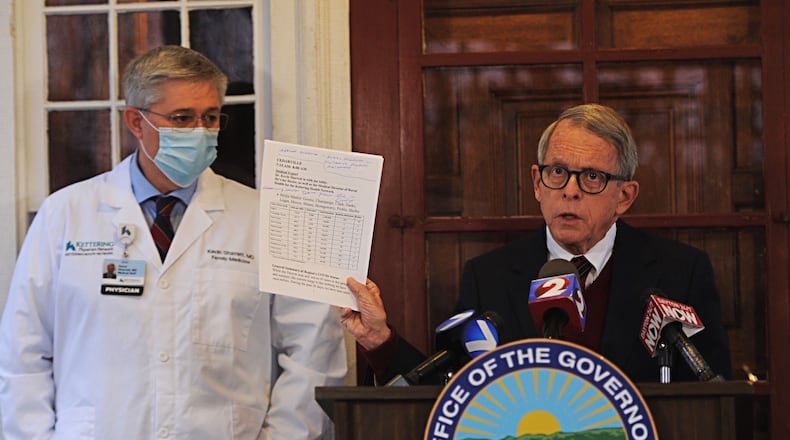“Age is the top indicator of the likelihood of death from COVID-19,” he said. “Eighty-seven percent of all deaths in Ohio are of those ages 65 and older. As we move forward in our vaccination plan, we will hold at age 65 and older until we have satisfied the vaccine demand in this age group.”
Similar to Phase 1B, the state will add groups eligible for the vaccine based off age groups decreasing by five years. The next group will start with people ages 60 and older before moving to 55 and older and then 50 and older. It’s not clear how much time will be between the addition of each age group.
“In addition, we are also looking at certain small groups that, because of exposure, may potentially be added in with the 60+ group,” DeWine said.
Nursing homes and long-term care facilities will receive a letter from the governor reminding them check their county’s positivity rate each week to determine their visitation status and to allow for compassionate care visits.
Examples of compassionate care visits include residents who need encouragement eating and drinking — something that was previously provided by family and caregivers or residents who used to talk and interact with others, but are experiencing emotional distress, crying more or speaking less.
Long-term care facilities are required to report updates in visitation each week to the state’s visitation dashboard. The dashboard allows people to search by county and see what visitation guidelines are in place.
The dashboard is color-coded to include red, yellow and green counties. Red counties do not permit visitation except in compassionate care circumstances. Yellow and green counties can allow visitation if they meet other criteria.
The governor noted that with the state’s positivity rates decreasing, visitations might be expanded in facilities soon.
Last week, long-term care facilities reported 343 new cases. During a peak in December, facilities reported 2,832 new cases in a week.
DeWine encouraged vaccine providers who had to cancel clinics due to winter weather delaying vaccine shipments to reschedule appointments as soon as possible.
“For providers who canceled appointments, we have urged them to expand their appointment schedules - including evening/weekend hours - to catch up and continue to get more vaccines out to Ohioans,” he said.
All Moderna vaccine shipments were delayed, as well as some Pfizer. The delayed shipments are expected to arrive between Monday and Wednesday, the governor said.
Some providers used to vaccines shipped for seconds doses to avoid canceling clinics. Those doses will be replaced and distributed to patients DeWine said.
Ohio reported fewer than 2,000 daily cases of coronavirus for the second day in a row on Monday, according to the Ohio Department of Health.
On Sunday the state recorded its fewest number of daily cases, 1,461. In the last week, Ohio has reported less than 2,000 daily cases three times.
Throughout the pandemic, 955,378 cases have been recorded in the state. Over the last 21 days, Ohio is reporting an average of 2,681 cases.
Hospitalizations increased by 120 and ICU admissions grew by 16 in the state for a total of 49,492 and 7,044 respectively.
Ohio added 58 deaths on Monday, bringing the state’s total to 16,874.
About the Author

